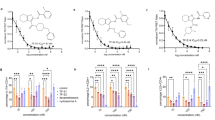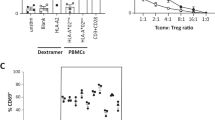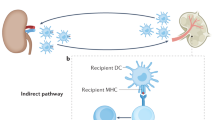Abstract
Allorejection remains an obstacle for successful organ transplantation. Although different types of immunosuppressive agents are effective for controlling rejection and prolonging graft survival, drug treatment is limited because of side effects and toxicity. Therefore, it is necessary and urgent to identify new candidate drugs for inducing allotolerance. Recently, it has been reported that bacterial flagellin induces the immunosuppressive activity of regulatory T cells (Tregs) in humans in vitro. In the present study, we analyzed the effects of recombinant flagellin (rFliC) on allograft survival and explored the underlying mechanisms associated with the activation of recipient Tregs in a murine skin allotransplantation model. The results showed that rFliC administration (3 mg/kg, once per day for 3 days, i.p.) prolonged allograft survival (mean survival time: 18.4±1.1 days) compared to the control group (10±0.7 days, P<0.01). Additionally, higher positive expression of Toll-like receptor 5 (TLR5) was detected within the allograft administered with rFliC. The frequency of CD4+CD25+Foxp3+ Tregs; the expression of Treg-related factors TLR5, Foxp3, TGF-β1 and IL-10; and the proliferation and suppression of Tregs were increased following rFliC administration compared to the control. Moreover, the increased expression of tolerance-related molecules and the proliferation of Tregs induced by rFliC were attenuated by an anti-TLR5 blocking antibody both in vivo and in vitro. In conclusion, rFliC administration prolongs the survival of allografts, which is associated with the activation of recipient Tregs in a TLR5-dependent manner. rFliC may be a new candidate for anti-allorejection therapy.
This is a preview of subscription content, access via your institution
Access options
Subscribe to this journal
Receive 12 digital issues and online access to articles
$119.00 per year
only $9.92 per issue
Buy this article
- Purchase on Springer Link
- Instant access to full article PDF
Prices may be subject to local taxes which are calculated during checkout




Similar content being viewed by others
References
Hall BM, Tran G, Hodgkinson SJ . Alloantigen specific T regulatory cells in transplant tolerance. Int Immunopharmacol 2009; 9: 570–574.
Liu H, Zhang C, Liang T, Song J, Hao J, Hou G . Inhibition of Pim2-prolonged skin allograft survival through the apoptosis regulation pathway. Cell Mol Immunol 2012; 9: 503–510.
Fontenot JD, Gavin MA, Rudensky A . Y. Foxp3 programs the development and function of CD4+CD25+ regulatory T cells. Nat Immunol 2003; 4: 330.
Hori S, Nomura T, Sakaguchi S . Control of regulatory T cell development by the transcription factor Foxp3. Science 2003; 299: 1057.
Khattri R, Cox T, Yasayko SA, Ramsdell F . An essential role for Scurfin in CD4+CD25+ T regulatory cells. Nat Immunol 2003; 4: 337.
Fontenot JD, Rasmussen JP, Williams LM, Dooley JL, Farr AG, Rudensky AY . Regulatory T cell lineage specification by the forkhead transcription factor foxp3. Immunity 2005; 22: 329.
Liu GW, Zhao Y . Toll-like receptors and immune regulation: their direct and indirect modulation on regulatory CD4+ CD25+ T cells. Immunology 2007; 122: 149–156.
Gururajan M, Jacob J, Pulendran B . Toll-like receptor expression and responsiveness of distinct murine splenic and mucosal B-cell subsets. PLoS ONE 2007; 2: e863.
West AP, Koblansky AA, Ghosh S . Recognition and signaling by Toll-like receptors. Annu Rev Cell Dev Biol 2006; 22: 409–437.
Ku CL, Yang K, Bustamante J, Puel A, von Bernuth H, Santos OF et al. Inherited disorders of human Toll-like receptor signaling: immunological implications. Immunol Rev 2005; 203: 10–20.
Rumbo M, Nempont C, Kraehenbuhl JP, Sirard JC . Mucosal interplay among commensal and pathogenic bacteria: lessons from flagellin and Toll-like receptor 5. FEBS Lett 2006; 580: 2976–2984.
Hayashi F, Smith KD, Ozinsky A, Hawn TR, Yi EC, Goodlett DR et al. The innate immune response to bacterial flagellin is mediated by Toll-like receptor 5. Nature 2001; 410: 1099–1103.
Mizel SB, Bates JT . Flagellin as an adjuvant: cellular mechanisms and potential. J Immunol 2010; 185: 5677–5682.
McSorley SJ, Ehst BD, Yu Y, Gewirtz AT . Bacterial flagellin is an effective adjuvant for CD4+ T cells in vivo. J Immunol 2002; 169: 3914–3919.
Shi W, Li YH, Liu F, Yang JY, Zhou DH, Chen YQ et al. Flagellin enhances saliva IgA response and protection of anti-caries DNA vaccine. J Dent Res 2012; 91: 249–254.
Bates JT, Graff AH, Phipps JP, Grayson JM, Mizel SB . Enhanced antigen processing of flagellin fusion proteins promotes the antigen-specific CD8+ T cell response independently of TLR5 and MyD88. J Immunol 2011; 186: 6255–6262.
Le TA, Takai T, Vu AT, Kinoshita H, Chen X, Ikeda S et al. Flagellin induces the expression of thymic stromal lymphopoietin in human keratinocytes via toll-like receptor 5. Int Arch Allergy Immunol 2011; 155: 31–37.
Vijay-Kumar M, Aitken JD, Sanders CJ, Frias A, Sloane VM, Xu J et al. Flagellin treatment protects against chemicals, bacteria, viruses, and radiation. J Immunol 2008; 180: 8280–8285.
Kumar A, Hazlett LD, Yu FS . Flagellin suppresses the inflammatory response and enhances bacterial clearance in a murine model of Pseudomonas aeruginosa Keratitis. Infect Immunity 2008; 76: 89–96.
Burdelya LG, Krivokrysenko VI, Tallant TC, Strom E, Gleiberman AS, Gupta D et al. An agonist of Toll-like receptor 5 has radioprotective activity in mouse and primate models. Science 2008; 320: 226–230.
Jarchum I, Liu M, Lipuma L, Pamer EG . Toll-like receptor 5 stimulation protects mice from acute Clostridium difficile colitis. Infect Immun 2011; 79: 1498–1503.
Crellin NK, Garcia RV, Hadisfar O, Allan SE, Steiner TS, Levings MK . Human CD4+ T cells express TLR5 and its ligand flagellin enhances the suppressive capacity and expression of FOXP3 in CD4+CD25+ T regulatory cells. J Immunol 2005; 175: 8051–8059.
Martin M, Rehani K, Jope RS, Michalek SM . Toll-like receptor-mediated cytokine production is differentially regulated by glycogen synthase kinase 3. Nat Immunol 2005; 6: 777–784.
Salamone GV, Petracca Y, Fuxman Bass JI, Rumbo M, Nahmod KA, Gabelloni ML et al. Flagellin delays spontaneous human neutrophil apoptosis. Lab Invest 2010; 90: 1049–1059.
Chen FQ, Qu LL, Zhang C, Liang T, Song J, Xu J et al. Effect of rapamycin and cyclosporin A on the expression of TLR5 and Foxp3 in allorejection. Xi Bao Yu Fen Zi Mian Yi Xue Za Zhi 2009; 25: 23–26. Chinese.
Hossain MS, Jaye DL, Pollack BP, Farris AB, Tselanyane ML, David E et al. Flagellin, a TLR5 agonist, reduces graft-versus-host disease in allogeneic hematopoietic stem cell transplantation recipients while enhancing antiviral immunity. J Immunol 2011; 187: 5130–5140.
Chen YS, Shiuan D, Chen SC, Chye SM, Chen YL . Recombinant truncated flagellin of Burkholderia pseudomallei as a molecular probe for diagnosis of melioidosis. Clin Diagn Lab Immunol 2003; 10: 423–425.
Valujskikh A, Matesic D, Gilliam A, Anthony D, Haqqi TM, Heeger PS . T cells reactive to a single immunodominant self-restricted allopeptide. J Clin Invest 1998; 101: 1398–1407.
Valujskikh A, Matesic D, Heeger PS . Characterization and manipulation of T cell immunity to skin grafts expressing a transgenic minor antigen. Transplantation 1999; 68: 1029–1036.
Valujskikh A, Heeger PS . CD4+ T cells responsive through the indirect pathway can mediate skin graft rejection in the absence of interferongamma. Transplantation 2000; 69: 1016–1019.
Liang T, Zhang C, Song J, Jiang S, Hao J, Hou G . Evaluation of 131I-anti-MIF mAb as a reporter for allograft rejection. Clin Immunol 2011; 139: 40–47.
Bluman EM, Schnier GS, Avalos BR, Strout MP, Sultan H, Jacobson FW et al. The c-kit ligand potentiates the allogeneic mixed lymphocyte reaction. Blood 1996; 88: 3887–3893.
Liu G, Duan K, Ma H, Niu Z, Peng J, Zhao Y . An instructive role of donor macrophages in mixed chimeras in the induction of recipient CD4+)Foxp3+ Treg cells. Immunol Cell Biol 2011; 89: 827–835.
Levitsky J, Gallon L, Miller J, Tambur AR, Leventhal J, Flaa C et al. Allospecific regulatory effects of sirolimus and tacrolimus in the human mixed lymphocyte reaction. Transplantation 2011; 91: 199–206.
Acknowledgements
This work was supported by grants from the National Natural Science Foundation of China (81071172, G. Hou) and the Natural Science Foundation of Shandong Province (ZR2010CM025, G. Hou).
Author information
Authors and Affiliations
Corresponding author
Additional information
Supplementary Information accompanies the paper on Cellular & Molecular Immunology's website.
Supplementary information
Rights and permissions
About this article
Cite this article
Hao, J., Zhang, C., Liang, T. et al. rFliC prolongs allograft survival in association with the activation of recipient Tregs in a TLR5-dependent manner. Cell Mol Immunol 11, 206–214 (2014). https://doi.org/10.1038/cmi.2013.44
Received:
Revised:
Accepted:
Published:
Issue Date:
DOI: https://doi.org/10.1038/cmi.2013.44
Keywords
This article is cited by
-
Toll-like receptor 5-mediated signaling enhances liver regeneration in mice
Military Medical Research (2021)
-
Over-activation of TLR5 signaling by high-dose flagellin induces liver injury in mice
Cellular & Molecular Immunology (2015)



